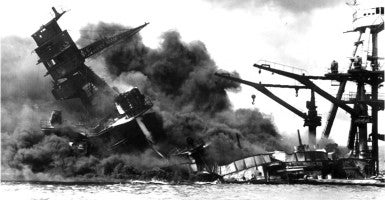Today marks the 74th anniversary of the Japanese attack on Pearl Harbor, which President Franklin D. Roosevelt famously called “a date which will live in infamy.” On this day, we should remember the resolve that our military and the American citizens displayed to the world in response to this attack.
The surprise attack killed over 2,400 Americans and wounded over 1,100 more. The U.S. also lost nearly 200 aircraft. Eight battleships, the primary instrument of naval power at the time, were sunk or damaged. Japan hoped that the attack would cripple the U.S. Pacific Fleet and deter it from slowing Japanese advances in the region. However, the Japanese military failed to account for the resiliency and “unbounding determination” of the American people.
After the attack, six of the sunken or damaged battleships were quickly repaired. Providentially, the Pacific Fleet’s aircraft carriers were not present at Pearl Harbor, thus preserving what would emerge as one of America’s most important naval assets. In his address to Congress requesting a declaration of war, Roosevelt noted that the American people would be undeterred in their response, saying, “No matter how long it may take us to overcome this premeditated invasion, the American people in their righteous might will win through to absolute victory.”
During World War II, the capabilities of the Navy, especially its aircraft carriers, proved to be the deciding factor in important battles like Coral Sea, Midway, Tarawa, the Philippine Sea, and Leyte Gulf.
This is largely because Admiral Chester Nimitz identified a lack of forward deployed maintenance capabilities to service our fleet thousands of miles from home port. He quickly set out to address this concern by establishing additional maintenance units that would be deployed with the fleet.
The U.S. Navy faces similar maintenance challenges today, partially caused by a shrinking fleet. Today, the Navy’s current battle force of 272 active ships is the smallest it has been since the U.S. entered World War I in 1917.
This is far short of the 346 ships advocated for by The Heritage Foundation in their 2016 Index of U.S. Military Strength. Furthermore, the Navy, like the rest of our Armed Forces, has been shackled by budget cuts that have reduced its ability to modernize its capabilities or even maintain its current fleet.
So today, while we remember those who lost their lives at Pearl Harbor as well as the sacrifices and resolve displayed by the “Greatest Generation,” the U.S. must not lose sight of the threats that face us today. Our government must remember its constitutional role to “provide for the common defense” and “provide and maintain a Navy” that will protect U.S. interests around the globe.
As former Chief of Naval Operations Admiral Jonathan Greenert often stressed, the Navy’s charge is to be “where it matters when it matters.”






























